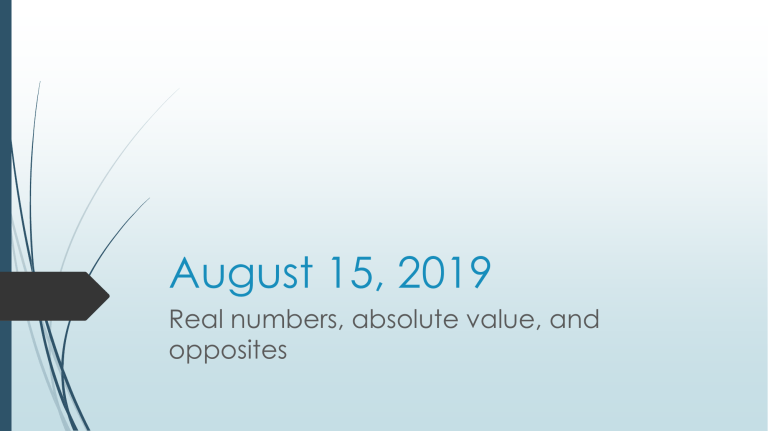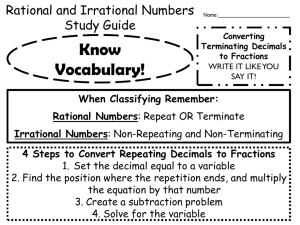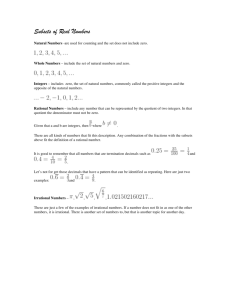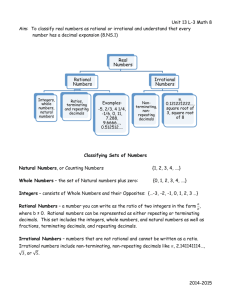
August 15, 2019
Real numbers, absolute value, and
opposites
Agenda
1) Bell work
2) Finish the syllabus overview
3) Note-taking process
4) Direct Instruction
5) Pairs/Trios Practice
6) Independent Practice
7) Homework reminder/announcements
8) Summarize the lesson
9) Exit Slip
Bell work
1) Please take a ruler off the table
2) Stand your name tag up on your desk
3) Download the August 15th presentation
on Canvas
4) Copy the Cornell notes’ template onto
pg. 7 of your composition notebook
5) Update your table of contents
6) Work on the note-taking homework
Encouraging Quotation
Table of Contents
1) Table of Contents
pgs. 1-2
2) Test Scores
pg. 3
3) Cornell notes’ template
pg. 4
4) Note-taking strategies(article and notes)
pg. 5
5) Abbreviations sheet
pg. 6
6) Real numbers, Absolute Value & Opposites pg. 7
1) The note-taking activity
Due Tuesday August 20th
Homework
Note-taking homework
Mark the text by:
Underlining note-taking tips
Circling the most important words in each paragraph
Take notes on pg.5 in your notebook while keeping the
essential question in mind (Essential Question: What are strategies I can use to take
better notes in school?)
Answer the Text based questions (on loose leaf paper)
Are notes considered a finished product or a work in process?
Your brain’s action during note taking is compared to which object?
What are four of the most important things to remember when taking notes?
Attention signal
Call and response
Math related
I state the first part
The class finishes the second part
I say, “Real numbers are”
The class says, “rational or irrational”
Learning target (Objective)/Essential
Question
Learning Target: Students will be
able to classify real numbers, find
absolute value, and find opposites.
Essential Question: How do you
classify real numbers, find absolute
value, and find opposites?
Standards
MAFS.6.NS.3.6a: Recognize opposite signs of
numbers as indicating locations on opposite sides of
0 on the number line; recognize that the opposite of
the opposite of a number is the number itself, e.g., –
(–3) = 3, and that 0 is its own opposite.
MAFS.6.NS.3.7c:Understand the absolute value of a
rational number as its distance from 0 on the
number line; interpret absolute value as magnitude
for a positive or negative quantity in a real-world
situation.
Standard
MAFS.8.NS.1.1: Know that numbers that
are not rational are called irrational.
Understand informally that every number
has a decimal expansion; for rational
numbers show that the decimal expansion
repeats eventually, and convert a
decimal expansion which repeats
eventually into a rational number.
The Real Number System
The Real Number System
Real Numbers
Real numbers consist of all the rational and irrational numbers.
The real number system has many subsets:
◦ Natural Numbers
◦ Whole Numbers
◦ Integers
Rational Numbers
Irrational Numbers
Natural Numbers
Natural numbers are the set of
counting numbers.
{1, 2, 3,…}
Whole Numbers
Whole numbers are the set of
numbers that include 0 plus the set
of natural numbers.
{0, 1, 2, 3, 4, 5,…}
Integers
Integers are the set of whole
numbers and their opposites.
{…,-3, -2, -1, 0, 1, 2, 3,…}
Rational Numbers
Rational numbers are any numbers
a
that can be expressed in thebform of
, where a and b are integers, and b ≠
0.
They can always be expressed by
using terminating decimals or
repeating decimals.
Terminating Decimals
Terminating decimals are decimals that
contain a finite number of digits.
Examples:
36.8
0.125
4.5
Repeating Decimals
Repeating decimals are decimals that contain a infinite
number of digits.
Examples:
0.333…
1.9
7.689689…
FYI…The line above the decimals indicate that number
repeats.
Irrational Numbers
Irrational numbers are any numbers that cannot be
expressed as
.
a
b
They are expressed as non-terminating, non-repeating
decimals; decimals that go on forever without repeating a
pattern.
Examples of irrational numbers:
0.34334333433334…
45.86745893…
(pi)
2
Other Vocabulary Associated with the Real
Number System
…(ellipsis)—continues without end
{ } (set)—a collection of objects or numbers. Sets are notated
by using braces { }.
Finite—having bounds; limited
Infinite—having no boundaries or limits
Venn diagram—a diagram consisting of circles or squares to
show relationships of a set of data.
Example
Classify all the following numbers as natural, whole, integer,
rational, or irrational. List all that apply.
a. 117
b. 0
c. -12.64039…
d. -½
e. 6.36
f.
g. -3
Venn Diagram of the Real Number System
Rational Numbers
Irrational Numbers
Your Turn
When taking the square root of any number
that is not a perfect square, the resulting
decimal will be non-terminating and nonrepeating. Therefore, those numbers are
always irrational.
FYI…For Your Information
Absolute value
Example
Practice Problems
Opposites
Examples
Practice problems
Question
How are absolute value
and opposites similar?
Exit Slip (Homework)
.
I can classify all the following numbers
as natural, whole, integer, rational, or
irrational, find their absolute value, and
find their opposites.
15, 0, -11.53148…, -1/4, 4.24, 8
Have a great day!






